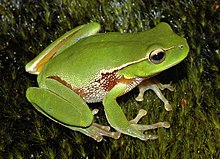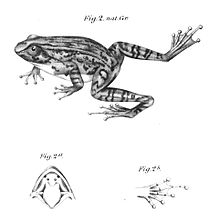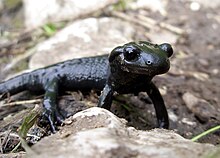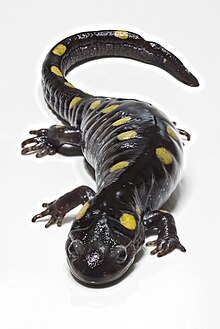Portal:Amphibians
The Amphibian Portal
Amphibians are ectothermic, anamniotic, four-limbed vertebrate animals that constitute the class Amphibia. In its broadest sense, it is a paraphyletic group encompassing all tetrapods excluding the amniotes (tetrapods with an amniotic membrane, such as modern reptiles, birds and mammals). All extant (living) amphibians belong to the monophyletic subclass Lissamphibia, with three living orders: Anura (frogs and toads), Urodela (salamanders), and Gymnophiona (caecilians). Evolved to be mostly semiaquatic, amphibians have adapted to inhabit a wide variety of habitats, with most species living in freshwater, wetland or terrestrial ecosystems (such as riparian woodland, fossorial and even arboreal habitats). Their life cycle typically starts out as aquatic larvae with gills known as tadpoles, but some species have developed behavioural adaptations to bypass this.
Young amphibians generally undergo metamorphosis from an aquatic larval form with gills to an air-breathing adult form with lungs. Amphibians use their skin as a secondary respiratory interface and some small terrestrial salamanders and frogs lack lungs and rely entirely on their skin. They are superficially similar to reptiles like lizards, but unlike reptiles and other amniotes, require access to water bodies to breed. With their complex reproductive needs and permeable skins, amphibians are often ecological indicators to habitat conditions; in recent decades there has been a dramatic decline in amphibian populations for many species around the globe.
The earliest amphibians evolved in the Devonian period from tetrapodomorph sarcopterygians (lobe-finned fish with articulated limb-like fins) that evolved primitive lungs, which were helpful in adapting to dry land. They diversified and became ecologically dominant during the Carboniferous and Permian periods, but were later displaced in terrestrial environments by early reptiles and basal synapsids (predecessors of mammals). The origin of modern lissamphibians, which first appeared during the Early Triassic, around 250 million years ago, has long been contentious. The most popular hypothesis is that they likely originated from temnospondyls, the most diverse group of prehistoric amphibians, during the Permian period. Another hypothesis is that they emerged from lepospondyls. A fourth group of lissamphibians, the Albanerpetontidae, became extinct around 2 million years ago. (Full article...)
Selected frog article
The Petropedetidae are a family of frogs containing two genera and 11 species. They are found in sub-Saharan tropical Africa and are sometimes known under common name African torrent frogs.
They are inhabitants of the splash-water zone of clear-running streams predominantly in forests. Tadpoles are either semiterrestrial in the spray zone or fully aquatic in zones of the strongest currents. Some species guard their clutches. They are medium- to large-sized frogs (Arthroleptides and Petropedetes). (Full article...)
Selected salamander article
The Salamandroidea are a suborder of salamanders, referred to as advanced salamanders. The members of the suborder are found worldwide except for Antarctica, sub-Saharan Africa, and Oceania. They differ from suborder Cryptobranchoidea as the angular and prearticular bones in their lower jaws are fused, their trunk ribs are bicapitate, and all members use internal fertilization. The female is fertilized by means of a spermatophore, a sperm-containing cap placed by the male in her cloaca. The sperm is stored in spermathecae on the roof of the cloaca until it is needed at the time of oviposition.
The earliest known salamandroid fossils remain contested. Some studies suggest that the earliest salamandroids are represented by specimens of the species Beiyanerpeton jianpingensis and Qinglongtriton gangouensis from the Tiaojishan Formation of Inner Mongolia, China, dated to the Late Jurassic about 157 million years ago. Alternative analyses suggest that Beiyanerpeton jianpingensis and Qinglongtriton gangouensis are stem salamanders and that the oldest known certain salamandroid is Valdotriton gracilis from the Early Cretaceous of Spain, about 127 Ma. (Full article...)
List of selected salamander articles
|
|---|
Did you know? –

- ... that the Pyrenean brook salamander sometimes lives entirely underground in caves?
- ... that Rhachitomi, a group of temnospondyl amphibians, was established as a clade in 2013?
- ... that the specific name of Tambachia trogallas, the type species of the trematopid temnospondyl Tambachia, refers to the Thuringian bratwurst that was frequently eaten by the describers of the species?
- ... that the female tree frog Aplastodiscus leucopygius inspects the underground nesting chamber prepared by the male before accepting his advances?
- ... that the Italian pool frog (pictured) has been introduced into the United Kingdom?
Selected amphibian type
Salamanders are a group of amphibians typically characterized by their lizard-like appearance, with slender bodies, blunt snouts, short limbs projecting at right angles to the body, and the presence of a tail in both larvae and adults. All ten extant salamander families are grouped together under the order Urodela from the group Caudata. Urodela is a scientific Latin term based on the Ancient Greek οὐρά δήλη: ourà dēlē "conspicuous tail". Caudata is the Latin for "tailed ones", from cauda: "tail".
Salamander diversity is highest in eastern North America, especially in the Appalachian Mountains; most species are found in the Holarctic realm, with some species present in the Neotropical realm. Salamanders never have more than four toes on their front legs and five on their rear legs, but some species have fewer digits and others lack hind limbs. Their permeable skin usually makes them reliant on habitats in or near water or other cool, damp places. Some salamander species are fully aquatic throughout their lives, some take to the water intermittently, and others are entirely terrestrial as adults.
This group of amphibians is capable of regenerating lost limbs as well as other damaged parts of their bodies. Researchers hope to reverse engineer the regenerative processes for potential human medical applications, such as brain and spinal cord injury treatment or preventing harmful scarring during heart surgery recovery. The remarkable ability of salamanders to regenerate is not just limited to limbs but extends to vital organs such as the heart, jaw, and parts of the spinal cord, showing their uniqueness compared to different types of vertebrates. This ability is most remarkable for occurring without any type of scarring. This has made salamanders an invaluable model organism in scientific research aimed at understanding and achieving regenerative processes for medical advancements in human and animal biology. (Full article...)
Selected images
Selected toad article

Scaphiopus holbrookii, commonly known as the eastern spadefoot, is a species of American spadefoot toad (family Scaphiopodidae) endemic to the eastern United States. It is not considered a true toad, with Bufonidae being the family of "true toads". (Full article...)
Selected caecilian article
The Scolecomorphidae (from Greek: σκώλεκώς skólekós, 'wormlike' and Greek: μορφή morphḗ, 'form') are a family of caecilians also known as tropical caecilians, buried-eyed caecilians, or African caecilians. They are found in Cameroon in West Africa, and Malawi and Tanzania in East Africa. Caecilians are legless amphibians which superficially resemble worms or snakes.
Scolecomorphids have only vestigial eyes, which are attached to the base of a pair of tentacles underneath the snout. Unlike other caecilians, they have only primary annuli; these are grooves running incompletely around the body, giving the animal a segmented appearance. All other caecilians have a complex pattern of grooves, with secondary or tertiary annuli present. Also uniquely amongst tetrapods, the scolecomorphids lack a stapes bone in the middle ear.
At least some species of scolecomorphids give birth to live young, retaining the eggs inside the females' bodies until they hatch into fully formed offspring, without the presence of a free-living larval stage. (Full article...)
Need help?
Do you have a question about Amphibians that you can't find the answer to?
Consider asking it at the Wikipedia reference desk.
Topics
Subcategories
Related portals
Associated Wikimedia
The following Wikimedia Foundation sister projects provide more on this subject:
-
Commons
Free media repository -
Wikibooks
Free textbooks and manuals -
Wikidata
Free knowledge base -
Wikinews
Free-content news -
Wikiquote
Collection of quotations -
Wikisource
Free-content library -
Wikiversity
Free learning tools -
Wiktionary
Dictionary and thesaurus











































